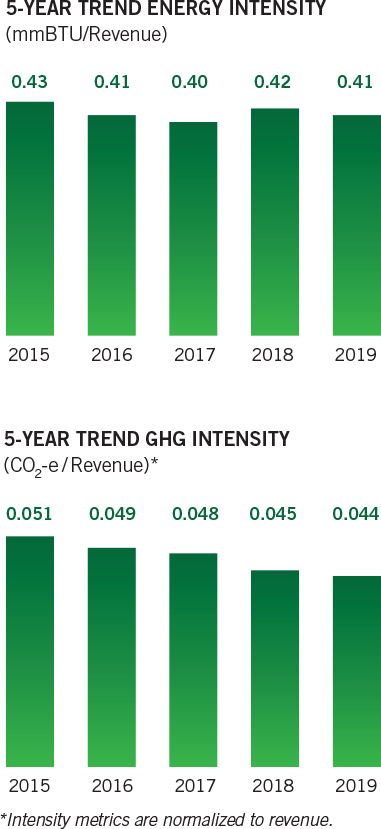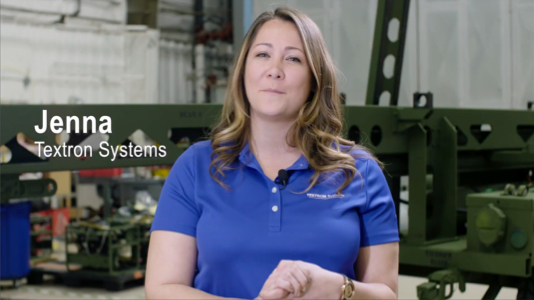TEXTRON – 2019 CORPORATE RESPONSIBILITY REPORT
Textron and the Environment
Textron understands its responsibility to participate in working toward a sustainable future for the environment. Our responsibility to the environment starts with our compliance with regulatory requirements and is supported by our Textron Global EHS Policies and Standards which we follow in all countries where we operate. Beyond compliance, we are focused on reducing the energy and natural resource intensity of our operations and contributing positively to the communities in which we operate.
Sustainable Footprint
All Textron business units set annual targets for energy efficiency, greenhouse gas emissions reduction and waste minimization. In 2019, these targets varied by business and generally represented between a 1 and 2.5% annual improvement.
TEXTRON’S 2019 SUSTAINABILITY PROJECTS: REDUCING OUR ENVIRONMENTAL FOOTPRINT
In 2019, Textron operations around the globe completed more than 150 sustainability projects aimed at energy, waste or water use reduction. In addition to saving Textron $3.3 million, these projects helped Textron improve by increasing energy efficiency and reducing greenhouse gas emissions, water use and waste generation. Project savings on energy were 83,000 mmBTUs, which resulted in reducing greenhouse gas emissions by 9,700 metric tons. Our waste minimization efforts helped to reduce our landfill disposal by almost 2,000,000 pounds. Water projects resulted in 6.5 million gallons of water savings.
2019 SUSTAINABILITY PERFORMANCE
The charts on this page show our 2019 performance and progress over the past five years on energy consumption and greenhouse gas emissions reduction, as well as our 2019 waste profile and water consumption. Intensity values are normalized to revenue.
Greenhouse Gas (GHG) Emissions
Greenhouse gas (GHG) emissions are determined following the Greenhouse Gas Protocols of the World Business Council for Sustainable Development and the World Resource Institute. Consistent with these protocols, Textron accounts for direct (Scope 1) and indirect (Scope 2) GHG emissions in terms of CO2-equivalents. Our greenhouse gas emissions and calculation methodology have been verified by an ANSI-accredited independent third party in accordance with ISO 14064-3.




NEW 5-YEAR SUSTAINABILITY GOALS ESTABLISHED
To further Textron’s longstanding commitment to the environment and natural resource conservation, in 2020 we established a new set of enterprise-wide 5-year improvement goals specific to the following areas of focus: greenhouse gas emissions, energy use, water use and waste generation. By 2025, Textron’s business will strive to achieve the following goals: 1) Reduce greenhouse gas emission intensity by 20%; 2) reduce energy use intensity by 10%; 3) reduce water use intensity by 10%, and; 4) reduce waste generation intensity by 10%.
2025 ENTERPRISE-WIDE GOALS

To achieve these goals by 2025, Textron intends to partner with our suppliers and stakeholders to carry out resource improvement projects at our facilities and continuously look for more efficient methods in our energy procurement and manufacturing processes.

TEXTRON: A U.S.
DEPARTMENT OF ENERGY
BETTER PLANTS
PROGRAM PARTNER
The U.S. Department of Energy’s (DOE’s) Better Buildings, Better Plants Program is a voluntary partnership initiative to drive significant energy efficiency improvement across energy intensive industrial companies and organizations. Textron is one of 234 leading manufacturers and utilities who partner with the DOE through Better Plants to improve competitiveness, drive energy efficiency, and save money.
ENVIRONMENTAL IMPROVEMENT HIGHLIGHTS
Textron Aviation To Power Kansas Facilities With Renewable Wind Energy
Textron Aviation is harnessing Kansas winds with a 20-year wind energy agreement signed with Evergy, Inc. to meet nearly all its electricity needs at the company’s facilities located in Wichita and Independence, Kansas, by utilizing renewable wind energy. Evergy’s new green energy program will allow Textron Aviation a path towards achieving its long-term sustainability goals using Kansas’ abundant, affordable and renewable wind energy.
The multi-year agreement with Evergy will provide Textron Aviation’s Kansas facilities with 55 megawatts (MW) of energy from a 300 MW wind farm being constructed near Manhattan, Kansas, in Nemaha County. The Soldier Creek Wind Farm is scheduled to be online by the end of 2020.
The purchase of renewable energy demonstrates our commitment to a more sustainable future for our employees, communities and customers. Textron Aviation expects to utilize nearly 20% of the zero-emission and renewable energy generated by the Soldier Creek Wind Energy Center.
Textron Aviation’s commitment to sustainability through this long-term renewable energy agreement also is expected to reduce the company’s energy costs by nearly 22%. Potential savings could reach in excess of $3 million over each five-year period of the agreement.
Textron Aviation uses enough energy to power about 22,500 homes. By supporting wind energy production in Kansas, Textron Aviation will significantly offset its carbon footprint.

Lycoming Engines Reduces Environmental Footprint
In the Green Room of the Lycoming Engines plant in Williamsport, Pennsylvania, crankshafts and cylinder barrels are hardened through a patented ion nitriding technology, rather than traditional caustic chemical processes, to reduce environmental footprint, while still providing the same quality product. This room contains solar tubes to provide supplemental natural light and an HVAC system that recirculates hot air in the room to heat the rest of the facility during the winter. These innovations have allowed Lycoming to reduce water usage by 400,000 gallons, electricity usage by 110,000 kWh and emissions by 1.2 million pounds annually.

Kautex Plants Harness Renewable Energy Sources
In March 2019, Kautex’s plant in Barcelona, Spain installed 1,350 solar panels on the roof of the facility which can achieve a maximum power capacity of 363kW. The solar panels are expected to produce 5.3% of the plant’s energy consumption which will result in an annual savings of approximately 50,000 €. In August 2019, Kautex’s plant in Guararema, Brazil switched to 100% renewable sources. This change will result in a reduction of over 250 metric tons of Greenhouse Gas Emissions annually.

